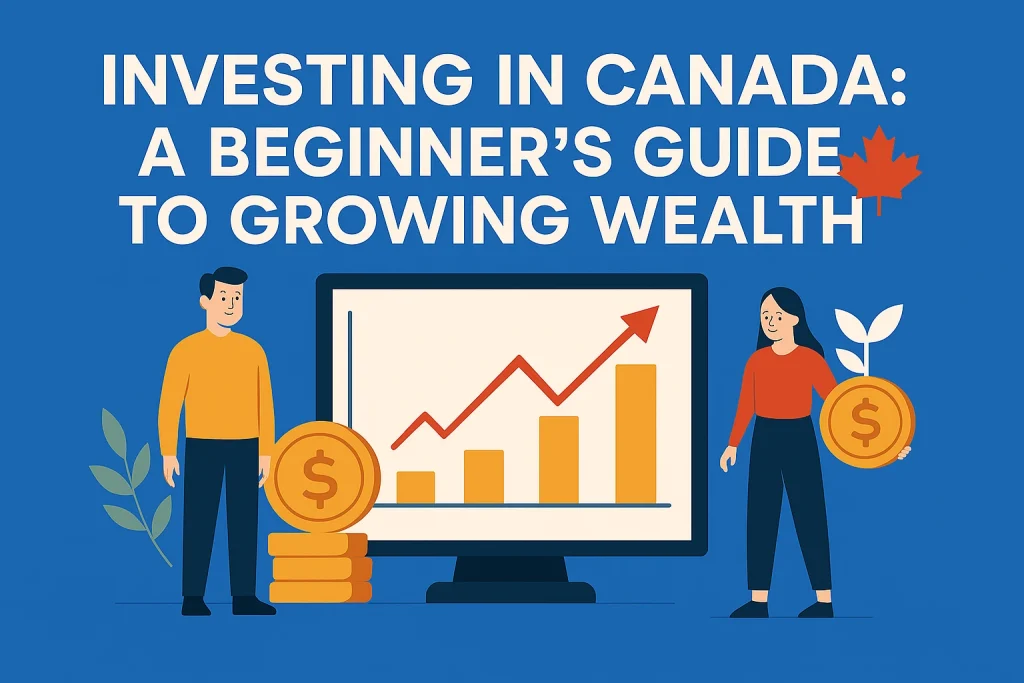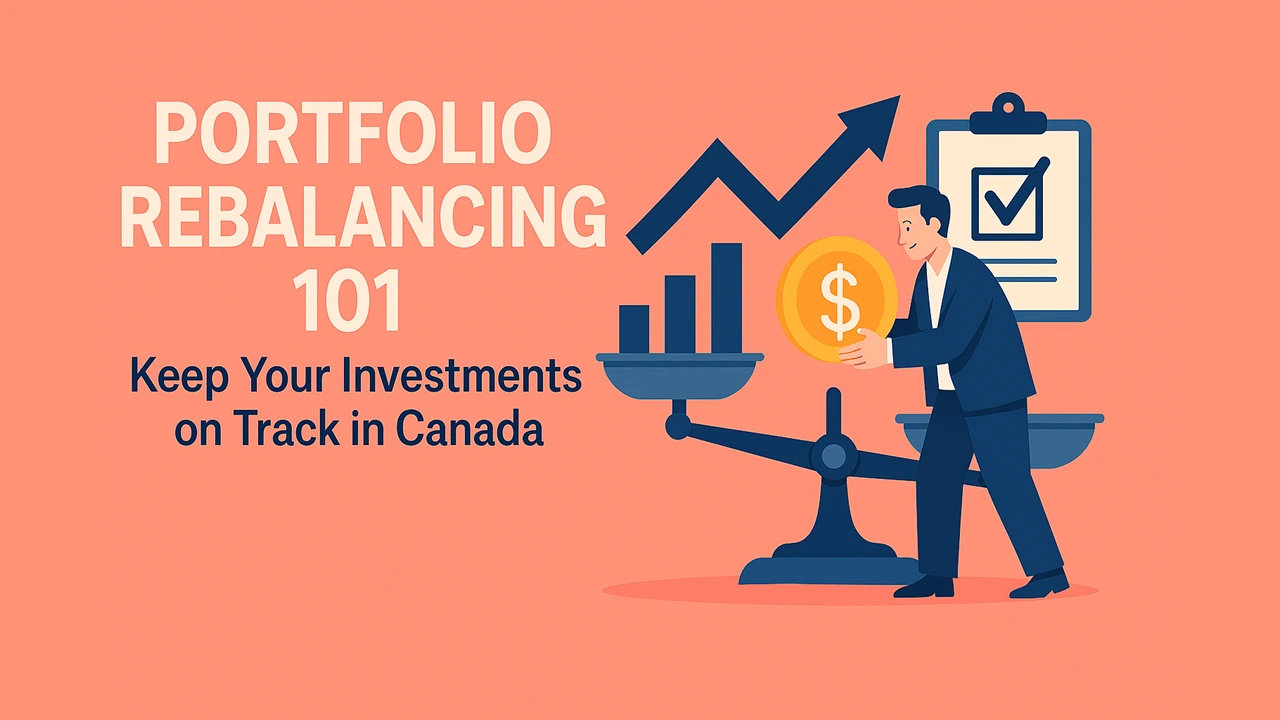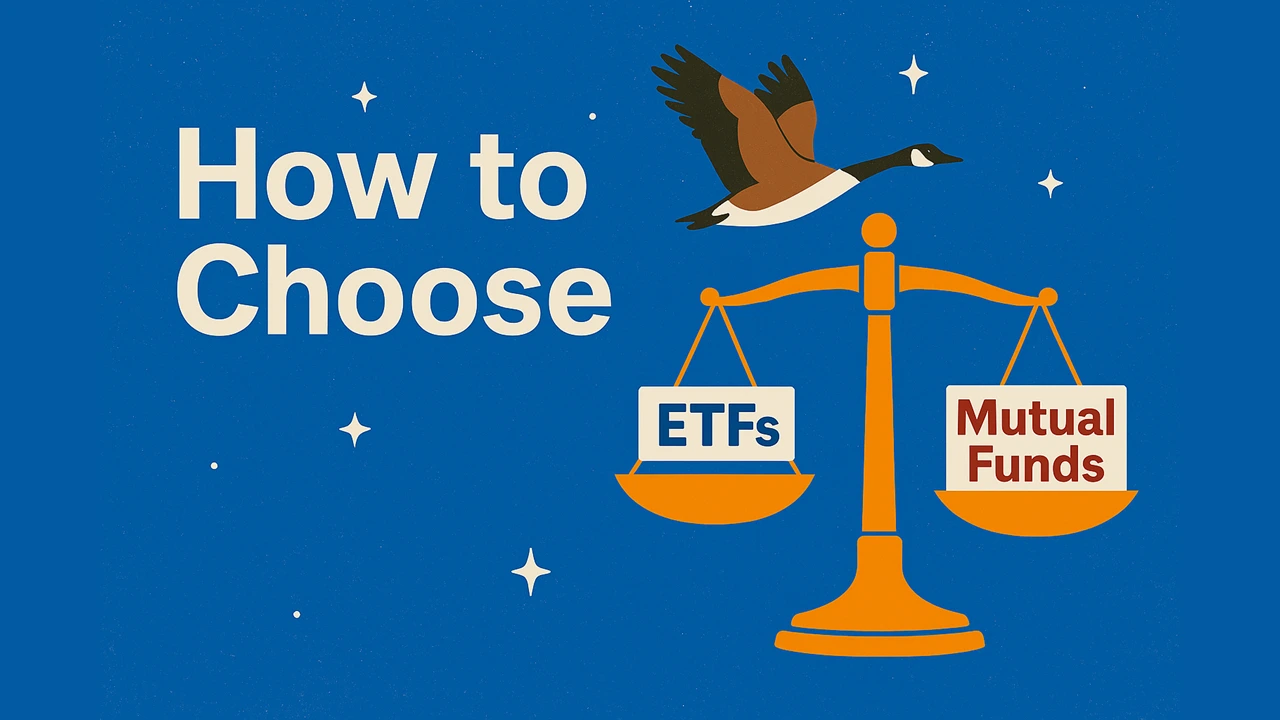Investing in Canada: A Beginner’s Guide to Growing Wealth

You work hard for your money — now it’s time to make it work for you. Investing isn’t just for experts or the wealthy. Even if you’re short on time or starting small, investing can help you grow wealth and reach your goals faster than saving alone.
You don’t need to pick stocks or follow the news — simple, low-effort strategies like index investing can build serious long-term results.
This guide breaks down everything you need to know to start investing in Canada: the accounts to use, the strategy to follow, and the common mistakes to avoid.
Ready? Let’s get started.
Why Investing Matters
If you’re relying only on savings, you’re falling behind. Inflation quietly eats away at your money’s value, meaning your cash buys less every year.
Investing helps you grow your money faster than inflation — and build real wealth over time.
Beat Inflation and Grow Your Money
Most Canadians earn less than 2% interest on savings, but inflation averages around 2%–3% per year. That means you’re actually losing money if you don’t invest.
Consider this: $10,000 today will only have the buying power of ~$8,000 in 10 years if left in a low-interest account.
Pro Tip
Want to protect your purchasing power? Invest in assets that grow faster than inflation — like ETFs or mutual funds.
📖 Learn more: How to Choose Between ETFs and Mutual Funds in Canada — And Avoid Big Mistakes
Investing vs. Saving: What’s the Difference?
While both saving and investing are key pillars of personal finance (check out our beginner guide), they serve different purposes and have different risk and return profiles.
Check out the table below for a comparison:
|
Saving |
Investing | |
|---|---|---|
|
Purpose |
Short-term needs, emergency fund, sinking fund |
Long-term growth, retirement, big goals |
|
Risk |
Very low (e.g., HISA/GICs) |
Varies, but higher than savings |
|
Return |
~1-2% in most bank accounts |
~6–8% annually (historically) |
|
Access |
Immediate (cash) |
May fluctuate in value, not ideal for short-term withdrawals |
Bottom line:
- Saving is for security.
- Investing is for building wealth.
Time Is Your Greatest Asset
The earlier you start, the more your money can grow thanks to compound returns. Even small, consistent investments add up big over time. Take Warren Buffett, who made 99% of his fortune after turning 50, through the power of compounding.
Example:
- Start at 25: $100/month for 30 years @ 7% = ~$113,000
- Start at 35: Same plan = only ~$54,000
Lesson: Waiting 10 years could cost you nearly half your future wealth.
What You Need Before You Start
Before you invest a single dollar, it’s important to have a few basics in place. These simple steps help reduce stress, avoid costly mistakes, and set you up for long-term success.
Build a Safety Net First
Investing comes with risk — so you want to set yourself up for any unexpected and expected expenses first.
This means, before investing, you should:
- Build an emergency fund to prepare yourself for any unexpected expenses, like your car breaking down, a leaky roof needing repair, or an emergency vet visit.
- Building a sinking fund for any expected expenses, like regular car or house maintenance, or property taxes.
Pro Tip
Pay off high-interest debt (like credit cards) before investing — your “return” from doing that is often 20%+.
Know Your Timeline & Goals
Different goals call for different investing strategies. Short-term goals require lower risk approaches. Long-term goals have more room for growth.
|
Goal |
Suggested Approach |
|---|---|
|
Buy a home in 3–5 years |
Conservative (e.g., GICs, bonds) |
|
Retire in 20+ years |
Growth-focused (ETFs) |
|
Save for kids’ education |
RESP with balanced fund |
Pro Tip
Be clear on when you’ll need the money before choosing how to invest it.
Understand Your Risk Tolerance
How much market volatility can you handle? Knowing your comfort level will help you choose the right mix of investments:
- Nervous seeing your balance drop? Stick with more conservative options, but risk missing out on returns and the power of compounding.
- Comfortable riding out the ups and downs? You may be fine with a growth-focused portfolio.
Pro Tip
Most robo-advisors and online brokers offer free questionnaires to assess your risk tolerance.
Having clarity about your risk tolerances sets you up to invest with confidence — not confusion.
Investing Accounts Canadians Should Know
Before you start investing, it’s important to choose the right type of account. In Canada, the type of account you use affects your taxes, how your money grows, and even how easily you can withdraw it later.
TFSA vs. RRSP: What’s Best for You?
Both are great tools — but they work differently. Here’s a direct comparison:
|
Feature |
TFSA |
RRSP |
|---|---|---|
|
Tax Treatment |
Tax-free growth & withdrawals |
Tax-deferred growth, taxed on withdrawal |
|
Contribution Room |
Set annually, unused room carries forward |
Based on income (18% up to annual max) |
|
Best For |
Flexibility, short– and long–term goals |
Retirement, higher income earners |
Bottom line:
- Usa a TFSA if you want flexibility and tax-free withdrawals.
- Use an RRSP to lower taxes now and grow money for retirement.
Pro Tip
Many Canadians benefit from using both accounts over time.
RESP, FHSA, and Non-Registered Accounts
Besides RRST and TFSA, Canada has mor accounts to offer, each with their own specific uses:
- RESP: Save for your child’s education—get up to $7,200 in government grants.
- FHSA: Save up to $8,000/year tax-free toward your first home.
- Non-Registered: No contribution limits, but you pay tax on investment income.
Don’t leave free money on the table, and make use of RESP grants and FHSA tax savings.
Pro Tip
Prioritize TFSAs and RRSPs first, then explore other options based on your goals.
Where to Open These Accounts
You can invest through your bank, an online brokerage, or a robo-advisor—each with pros and cons.
|
Option |
Popular Providers |
Best For |
|---|---|---|
|
Big Banks |
RBC Direct Investing, TD Direct Investing |
Comfort and in-person service |
|
Online Brokerages |
Questrade, Wealthsimple Trade |
Lower fees, DIY investors |
|
Robo-Advisors |
Wealthsimple Invest, Questwealth |
Hands-off investors (automated portfolios) |
Pro Tip
Robo-advisors are great for beginners—they handle everything automatically, for a small fee.
Investing Strategy: Passive vs. Active (What Actually Works)
You’ve chosen your account—now what do you put in it? This is where investment strategy comes in. Most beginners wonder: Should I pick individual stocks, or stick to index funds?
Here’s what you need to know.
Active Investing (Stock Picking)
Active investing means choosing individual stocks, trying to beat the market, or timing your trades based on news or trends.
|
Pros |
Cons |
|---|---|
|
Potential for big gains |
High risk of losses |
|
Full control over investments |
Time-consuming and stressful |
|
Feels exciting or “hands-on” |
Requires constant research and decisions |
⚠️Reality check: Over 80% of professional fund managers underperform the market over time. Chances are, you won’t either.
Pro Tip
If you’re busy or new to investing, stock picking is usually not worth the risk.
Passive Investing (Index Funds & ETFs)
Passive investing means buying diversified, low-cost funds that track the market (like the S&P 500 or TSX Index) and holding them long-term.
Here’s a breakdown of the pros and cons of passive investing:
|
Pros |
Cons |
|---|---|
|
Low fees = more money for you |
Less excitement (but that’s a good thing) |
|
Broad diversification = less risk |
Short-term dips still happen |
|
Requires little time or knowledge |
You won’t “beat” the market (but you’ll match it) |
☝️ Fun fact: Passive investors often outperform active traders — simply by doing less and not reacting to shot-term noise.
Pro Tip
If you want to invest without stress, stick to index ETFs or robo-advisors that do it for you.
Why Passive Wins for Most Canadians
For most Canadians, passive investing is the way to go. Here’s why:
- It’s less risky, less time-consuming, and more consistent than trying to outsmart the market.
- You get exposure to hundreds or thousands of companies with just one fund.
- Data shows: even pros can’t reliably beat index returns — so why try?
“By periodically investing in an index fund, the know-nothing investor can outperform most investment professionals.” — Warren Buffett
Pro Tip
If you’re not sure where to begin, passive investing is the smart, beginner-friendly choice.
How to Start Investing (Even If You’re Busy)
You don’t need to be a financial expert—or have a lot of time—to start investing. With today’s tools, it’s easier than ever to get started in just a few clicks.
Robo-Advisors vs. DIY ETF Portfolios
You have two beginner-friendly options:
- Robo-advisors: Fully automated investing—set it and forget it (e.g. Wealthsimple, Questwealth)
- DIY ETF portfolios: Build your own portfolio using index ETFs. They are cheaper, but it takes a bit more work (e.g., Questrade, TD Direct Investing)
|
Option |
Best For |
Pros |
Cons |
|---|---|---|---|
|
Robo-Advisor |
Busy Canadians, beginners |
Automated, hands-off, smart rebalancing |
Slightly higher fees (~0.25–0.50%) |
|
DIY ETFs |
Cost-conscious DIYers |
Lowest fees, full control |
You manage everything manually |
Pro Tip
If you want zero effort, start with a robo-advisor. You can always switch to DIY later if you want more control.
Dollar-Cost Averaging Explained
Instead of investing a large sum all at once, dollar-cost averaging means investing smaller amounts regularly (e.g. every payday).
Benefits:
- Reduces timing risk
- Smooths out market ups and downs
- Builds discipline through automation
- No thinking necessary
Example: Invest $250 every month instead of $3,000 all at once. You automatically buy more shares when prices are low, and fewer when they are high — no brain power involved.
Pro Tip
Set up automatic contributions through your robo-advisor or brokerage account.
Automate Everything
The less you have to think about it, the more consistent (and successful) you’ll be.
What to automate:
- Monthly transfers from your chequing to your TFSA/RRSP
- Auto-invest features (available on most robo platforms)
- Dividend reinvestment (DRIP)
Investing consistently beats trying to time the market and listening to short-term noise. Automating everyting will get you there.
Investing Mindset for Busy Canadians
Even the best investing strategy won’t work if you panic when the market drops. A strong mindset is what keeps your money growing over decades—not just months.
Long-Term Over Short-Term
Markets go up and down, but over time, they’ve always gone up.
Fun facts:
📉 In 2008, markets dropped ~35%—but fully recovered within 5 years.
📈 Investors who stayed invested made back more than they lost.
Pro Tip
Don’t check your portfolio daily. Think in years — not days.
Don’t Chase Trends
Jumping into “hot” investments (crypto, meme stocks, penny stocks) usually leads to regret.
|
Trend |
What Opten Happens |
|---|---|
|
Everyone’s buying in |
Price spikes fast |
|
Then it crashes |
Late investors take the biggest hit |
|
Result |
You sell low and lose money |
☝️ Fun fact: Boring is best (when it comes to investing). A simple index fund will likely outperform most trendy investments in the long-run.
Pro Tip
If you hear about it on social media, it’s probably too late.
Stay the Course
Sticking to your plan — even when markets dip — is one of the hardest but most powerful things you can do.
☝️ Fun fact: Missing the 10 best days in the market can cut your returns in half.
Pro Tip
Schedule a once-a-year check-in to rebalance and review your portfolio — then leave it alone.
Common Investing Mistakes to Avoid
Even smart, well-intentioned investors make simple mistakes that can cost thousands over time. Here are the most common ones — and how to avoid them.
Waiting Too Long to Start
Many Canadians wait until they “have more money” or “feel ready.” But the longer you wait, the more growth you miss out on.
Pro Tip
Start small now — even $25/month is better than waiting another year.
Overtrading or Checking Too Often
Checking your investments too frequently can lead to emotional decisions like panic-selling during market dips.
Pro Tip
Log in once or twice a year. Let your plan do the work.
Ignoring Fees and Taxes
High-fee mutual funds, hidden advisor commissions, and poor account choices can quietly eat away at your returns.
❗ Watch out for:
- MERs (Management Expense Ratios) over 1.5%
- Front-loaded or trailing commissions
- Investing outside registered accounts (when not needed)
Lower costs mean you keep more of your money. That’s why passive investment products like ETFs are the go-to for smart, low-fee investing.
Conclusion
Investing doesn’t have to be complicated—even for busy Canadians. With the right approach, you can build long-term wealth without stress or constant effort.
- 🧱 Build a financial base first (emergency fund + pay down high-interest debt)
- 💼 Use tax-efficient accounts like TFSAs and RRSPs
- 📊 Choose passive investing (like index ETFs) for long-term success
- 🤖 Automate your investments so you don’t have to think about them
- 🧠 Stick to your plan—consistency beats perfect timing
- 🚫 Avoid common mistakes like panic-selling, chasing trends, or paying high fees
Start small, keep it simple, and let time and consistency grow your wealth.


